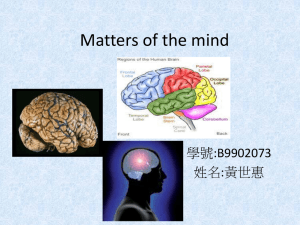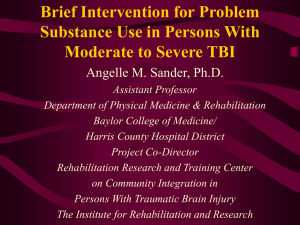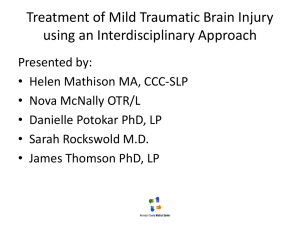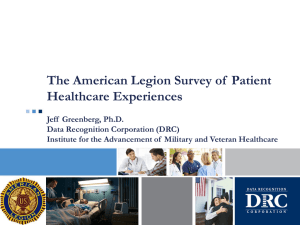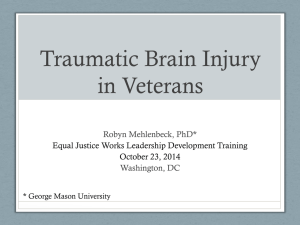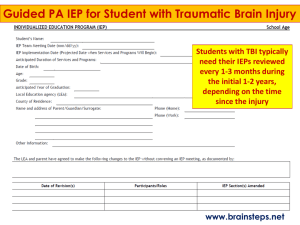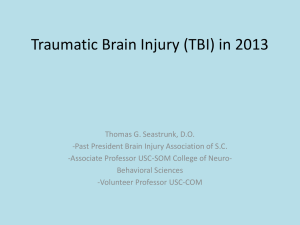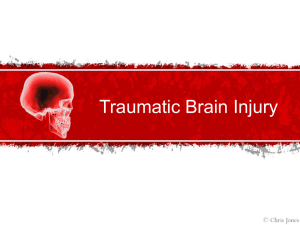Examples of Functional Neuroanatomy
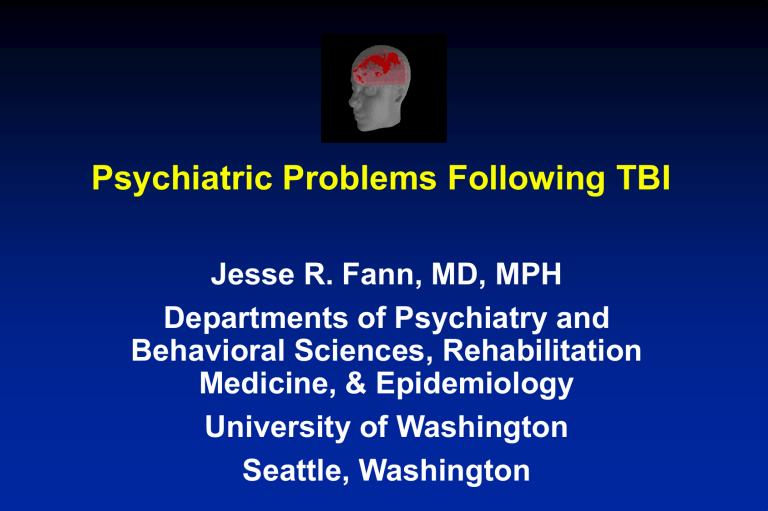
Psychiatric Problems Following TBI
Jesse R. Fann, MD, MPH
Departments of Psychiatry and
Behavioral Sciences, Rehabilitation
Medicine, & Epidemiology
University of Washington
Seattle, Washington
Domains of TBI
• Neurobiological Injury
– Consequences of direct injury to brain
• Traumatic Event
– Risk for Post-traumatic Stress Disorder,
Depression
• Chronic Medical Illness
– May lead to long-term symptoms & disability
TBI as Neurobiological Injury
• Primary effects of TBI
– Contusions, diffuse axonal injury
• Secondary effects of TBI
– Hematomas, edema, hydrocephalus, increased intracranial pressure, infection, hypoxia, neurotoxicity, inflammation
• Can affect mood modulating systems including serotonin, norepinephrine, dopamine, acetylcholine, and GABA
(Hamm et al 2000; Hayes & Dixon 1994)
Non-penetrating TBI
Diffuse Axonal Injury
Contusion
Subdural Hemorrhage
Taber et al 2006
Examples of Neuropsychiatric Syndromes
Associated with Neuroanatomical Lesions
• Leteral orbital pre-frontal cortex
– Irritability - Impulsivity
– Mood lability - Mania
• Anterior cingulate pre-frontal cortex
– Apathy - Akinetic mutism
• Dorsolateral pre-frontal cortex
– Poor memory search - Poor set-shifting / maintenance
• Temporal Lobe
– Memory impairment - Mood lability
– Psychosis
• Hypothalamus
– Sexual behavior
- Aggression
- Aggression
Mayberg et al, J Neuropsychiatry Clin Neurosci
TBI as Traumatic Event
• PTSD Prevalence: 11-27% *
– Possibly more prevalent in mild TBI
– Mediated by implicit memory or conditioned fear response in amnestic patients?
• PTSD Phenomenology: **
– Intrusive memories: 0-19%
– Emotional reactivity: 96%
– Intrusive memories, nightmares, emotional reactivity had highest predictive power
• Anxiety often comorbid with / prolongs depression
* Warden 1997, Bryant 1995, Flesher 2001, Bombardier 2006
** Warden et al 1997, Bryant et al 2000
Psychiatric Illness in Adult HMO Enrollees
(N=939 with TBI, 2817 controls)
Psychiatric Illness by TBI*
0.90
0.80
0.70
0.60
0.50
0.40
0.30
0.20
0.10
0.00
none mild mod./severe
No Prior Psychiatric Illness Prior Psychiatric Illness
6 12 18 24 30 36
Month
6 12 18 24 30 36
* Predicted proportions for a women of age 40-44 with median index month (6), median log cost and no comorbid injuries
Fann et al. Arch Gen Psychiatry 2004; 61:53-61
0.90
0.80
0.70
0.60
0.50
0.40
0.30
0.20
0.10
0.00
Psychiatric Disorder & MTBI
20
18
16
14
12
10
8
6
4
2
0
MDD GAD Agora PTSD Social Ph Panic
MTBI
No TBI
Bryant et al., Am J Psychiatry, in press
Neuropsychiatric Sequelae
• Delirium
• Depression
• Mania
• Anxiety
• Psychosis
• Cognitive Impairment
• Aggression, Agitation, Impulsivity
• Insomnia
Examples of Neuropsychiatric Syndromes
Associated with Neuroanatomical Lesions
• Leteral orbital pre-frontal cortex
– Irritability - Impulsivity
– Mood lability - Mania
• Anterior cingulate pre-frontal cortex
– Apathy - Akinetic mutism
• Dorsolateral pre-frontal cortex
– Poor memory search - Poor set-shifting / maintenance
• Temporal Lobe
– Memory impairment - Mood lability
– Psychosis
• Hypothalamus
– Sexual behavior
- Aggression
- Aggression
Neuropsychiatric Evaluation and
Treatment: Etiologies
Psychiatric Neurologic/Medical Social
Premorbid
Psych disorders & sxs.
Personality traits
Coping styles
Substance Abuse
Medication side effects
& interactions
Psychodynamic signif.
of neurologic illness
Family psych. history
Neurologic illness
Lesion location, size, pathophysiology
Other medical illness
Other indirect sequelae
(e.g., pain, sleep disturb)
Medication side effects
& interactions
Social, family, vocation
Rehabilitation situation and stressors
Functional impairment
Medicolegal
Roy-Byrne P, Fann JR. APA Textbook of Neuropsychiatry, 1997
Neuropsychiatric Evaluation and
Treatment: Workup
Psychiatric Neurologic/Medical Social
Psychiatric history & examination
Neuropsychological testing
Psychodynamic signif. of neuropsychiatric sxs., disability and treatments
Medical history and physical examination
Appropriate lab tests e.g., CBC, med blood levels, CT/MRI, EEG
Medication allergies
Interview family, friends, caregivers
Assess level of care & supervision available
Assess rehab needs
& progress
Neuropsychiatric History
Psychiatric symptoms may not fit DSM-IV criteria
Focus on functional impairment
Document and rate symptoms (use validated instruments)
Assess pre-TBI personality, coping, psychiatric history
Talk with family, friends, caregivers
Explore circumstances of trauma
LOC, PTA, hospitalization, medical complications
Subtle symptoms - may fail to associate with trauma
How has life changed since TBI?
Thorough review of medical and psychiatric sxs.
Assess level of care and supervision available
Assess rehabilitation needs and progress
Neuropsychiatric Treatment
• Use Biopsychosocial Approach
• Treat maximum signs and symptoms with fewest possible medications
• TBI patients more sensitive to side effects
START LOW, GO SLOW, BUT GO
• May still need maximum doses
• Therapeutic onset may be latent
• Some medications may lower seizure threshold
• Some medications may slow cognitive recovery
• Monitor and document outcomes
• Few randomized, controlled trials
Delirium
• Acute disturbance of consciousness, cognition and/or perception
• Increased risk in patients with TBI
• Undiagnosed in 32-67% of patients
– Often missed in both inpatient and outpatient settings
• Associated with 10-65% mortality
• Can lead to self-injurious behavior, decreased selfmanagement, caregiver management problems
• Associated with increased length of hospital stay and increased risk of institutional placement
• Other terms used to denote delirium: acute confusional state, intensive care unit (ICU) psychosis, metabolic encephalopathy organic brain syndrome, sundowning, toxic encephalopathy
Delirium
• Identify and correct underlying cause
– TBI increases a person’s vulnerability
– e.g., seizures, hydrocephalus, hygromas, hemorrhage, drug side effect or interactions, endocrine (hypothalamic, pituitary dysfunction), metabolic
(e.g., sodium, glucose), infections
• Pharmacologic management
–
Antipsychotics
» Haloperidol (e.g., IV), droperidol, risperidone, olanzapine, quetiapine
(taper 7 – 10 days after return to baseline)
–
Benzodiazepines (combined with antipsychotics), alcohol or sedative withdrawal
» lorazepam
• Minimize polypharmacy
• Medical management
– Frequent monitoring of safety , vital signs, mental status and physical exams
–
Maintain proper nutritional, electrolyte, and fluid balance
• Behavioral Management – safety, orientation, activation
Depression / Apathy
• Prevalence of major depression 44.3% *
– Assess pre-injury depression and alcohol use
– Use ‘inclusive’ diagnostic technique
– May occur acutely or post-acutely
– Not directly related to TBI severity
• Apathy alone - prevalence 10%
– disinterest, disengagement, inertia, lack of motivation, lack of emotional responsivity
* van Reekum et al. J Neuropsychiatry Clin Neurosci 2000;12:316-327
DSM-IV Major Depressive Disorder (MDD)
1. Depressed mood*
2. Loss of interest/pleasure*
3. Sleep disturbance
4. Poor energy
5. Motor change agitation or slowness
6. Weight/appetite change increase/decrease
7. Impaired concentration or indecision
8. Excessive worthlessness or guilt
9. Recurrent thoughts of death or suicide
• At least one of the essential criteria* and a total of at least 5 symptoms endorsed most of the day most days for at least 2 weeks
• Must cause clinically significant impairment
APA, Diagnostic & Statistical Manual of Mental Disorders, 4 th ed, 2000
Transdiagnostic Symptoms
TBI
1.
Depressed mood
2.
Anhedonia
3.
Weight loss/gain
4.
Insomnia/hypersomnia
5.
Psychomotor changes
6.
Fatigue
7.
Worthlessness/guilt
8.
Poor concentration
9.
Thoughts of death/suicide
X
X
X
X
Patient Health Questionnaire - 9
Over the last 2 weeks, how often have you been bothered by any of the following problems?
Not at all
Several days
More than half the days
1. Little interest or pleasure in doing things
2. Feeling down, depressed, or hopeless
3. Trouble falling or staying asleep, or sleeping too much
0
0
0
1
1
1
2
2
2
4. Feeling tired or having little energy
5. Poor appetite or overeating
6. Feeling bad about yourself — or that you are a failure or have let yourself or your family down
7. Trouble concentrating on things, such as reading the newspaper or watching television
8. Moving or speaking so slowly that other people could have noticed?
Or the opposite — being so fidgety or restless that you have been moving .around a lot more than usual
0
0
0
0
0
1
1
1
1
1
2
2
2
2
2
9. Thoughts that you would be better off dead or of hurting yourself in some way
0 1 2 3
Spitzer et al. JAMA 1999
Nearly every day
3
3
3
3
3
3
3
3
Rates Of Major Depression After TBI
53%
N = 559
Point Prevalence of MDD
Range 21-31%, no trend
Cumulative Rate of MDD as a
Function of Depression History
73%*
69%*
41%
*P < .001; independent predictors after adjusting for all other variables
Rate of MDD by History of Lifetime
Alcohol Dependence
70%*
45%
*P < .001; independent predictor after adjusting for all other variables
Cumulative Rate of MDD by PTSD History
81%
51%
Univariate predictor, not significant after adjusting for other variables
Comorbidity of Anxiety and MDD
100
90
80
70
60
50
40
30
20
10
0
MDD-
MDD+
1
27
6
54
Panic Disorder Other Anxiety Disorder
Any comorbid anxiety disorder in MDD+ vs. MDD-
(60% vs. 7%; RR, 8.77; CI, 5.56-13.83)
Depression / Apathy
• Selective serotonin re-uptake inhibitors (SSRIs)
sertraline
citalopram
- paroxetine
- escitalopram
- fluoxetine
venlafaxine, duloxetine (may help with pain)
• bupropion (may decrease seizure threshold)
• nefazedone (may be too sedating, liver toxicity)
• mirtazapine (may be too sedating)
• Tricyclics: nortriptyline, desipramine (blood levels)
• methylphenidate, dextroamphetamine
• Electroconvulsive Therapy – consider less frequent, nondominant unilateral
• Apathy : Dopaminergic agents - methylpyhenidate, pemoline, bupropion, amantadine, bromocriptine, modafinil
Fann et al, J Neurotrauma 2009
Number of Postconcussive
Symptoms
7
# of symptoms
3
4
5
2
7
6
* p=.05
* p=.05
0
1
3.9
3.5
2.2
All symptoms *
Current Depression No current Depression
**
PCS – Depression Study
Headache
(Baseline and Week 8)
Dizziness
Blurred Vision
Bothered by Noise
Bothered by Light
Loss of Temper
** Fatigue
Trouble Concentrating
*
Irritability
* Memory Difficulties
Anxiety
*
Sleep Disturbance
*p<.05
**p<.01
0 2 4 6 8 10 12
Improving
Worsening
Same
14 16
Treatment options
• Antidepressant medications :
– Particularly for major depression and dysthymia
• Psychotherapy : for all forms of depression (esp. CBT)
– Pro : no side effects, may last longer (‘learning effect’), addresses interpersonal / real life problems, flexible delivery options
– Con : may need to adapt for cognitive impairment , may cost more and take longer to work, more time consuming, may not be as effective for severe major depression
• Other psychosocial interventions (e.g., educational & support groups)
• Support and watchful waiting
• Often optimal treatment with combination of antidepressants and psychotherapy
Modifiable Risk Factors
Depression
Neurobiological
Factors
Cognitive
Distortions
No Pleasant
Activities Psychosocial
Adversity
Sedentary Lifestyle
L ife
I mprovement
F ollowing
T raumatic Brain Injury:
A Trial of C ognitive-Behavioral Therapy for Depression after TBI
Jesse R. Fann, MD, MPH
Departments of Psychiatry & Behavioral
Sciences and Rehabilitation
Medicine
School of Medicine
Department of Epidemiology
School of Public Health
University of Washington
Charles H. Bombardier, PhD
Steven Vannoy, PhD
Peter Esselman, MD
Kathy Bell, MD
Nancy Temkin, PhD
University of Washington
Evette Ludman, PhD
Group Health Research Inst
Reason
Slowed information processing & responding
Impaired attention & concentration
Accommodations
Present information at slower rate
Allow client more time to respond
Provide written summary of session beforehand
Minimize environmental stimulation and distractions during session
Focus on one topic at a time, Use shorter sessions
Avoid need for multi-tasking e.g., no note taking while listening
Impaired learning
& recall
Provide written summary of session (patient workbook)
Assign simple written homework
Provide written educational materials or workbook
Plan additional practice of CBT skills within session (over-learn skills)
Impaired verbal abilities
Impaired initiation & generalization
Impaired motivation
Minimize emphasis on verbally mediated aspects of CBT
Emphasize behavioral activation and pleasant events scheduling
Include family or friend in treatment planning and homework assignments
Provide 2 sessions devoted to generalization and relapse prevention at end
Use motivational interviewing techniques to engage subjects in therapy
Provide care management activities aimed at return to work, school or other meaningful roles and finding effective rehabilitation resources
Mania
• Prevalence of Bipolar Disorder 4.2% * after TBI
• Look for:
– elevated, expansive or irritable mood
– grandiosity
– decreased need for sleep
– pressured speech
– flight of ideas, distractability
– impuslivity
• High rate of irritability, “emotional incontinence”
• May be associated with epileptiform activity
• Potential interaction of genetic loading, right hemisphere lesions, and anterior subcortical atrophy
* van Reekum et al. J Neuropsychiatry Clin Neurosci 2000;12:316-327
Mania
• Acute
– Benzodiazepines
– Antipsychotics
» olanzapine, risperidone, quetiapine, clozapine
– Anticonvulsants
» valproate
– Electroconvulsive Therapy
• Chronic
– valproate
– carbamazepine
– lamotrigine
– lithium carbonate (neurotoxicity)
– gabapentin, topiramate (adjunctive treatments)
Pseudobulbar Affect
A neurologic condition characterized by episodes of crying or laughing that are sudden, frequent, and involuntary
Occurs in patients with TBI, MS, ALS, stroke, and certain other neurologic conditions
FDA-approved in 2011 – Nuedexta ®
Dextromethorphan (20mg) – modulates glutamate
+
Quinidine (10mg) – metabolic inhibitor
Anxiety Disorders
• Adjustment Disorder
• Posttraumatic Stress Disorder
• Panic Disorder
• Generalized Anxiety Disorder
• Specific Phobia – e.g., medical procedures
• Obsessive-Compulsive Disorder
• Anxiety Disorder due to General Medical Condition (e.g., hypoxia, sepsis, pain)
• Substance-induced Anxiety Disorder
Rates of Anxiety Disorders (civilians)
GAD PTSD OCD Panic Phobias Sample
24% NA NA 4% 2% Agoraphobia 50 patients diagnosed with TBI seen at a rehabilitation clinic -mean 32.5 months post injury
Fann et al.,
1995
8% 17% 14% 11% 7% 100 patients with TBI - mean 7.6 years post injury
Hibbard et al.,
1998
3%
17%
3%
14%
2%
1%
9%
6%
1% 100 patients hospitalized for TBI - 1 year post injury
Deb et al., 1999
7%
Specific Phobia
6%
Social Phobia
1% Agorophobia
100 patients hospitalized for TBI assessed 0.5 - 5.5 years post injury
13.4% 13% 4% 7.5% 12.8%
Agoraphobia
9% Social Phobia
817 patients hospitalized for traumatic injury (40% TBI) - assessed 1 year post injury
Whelan-
Goodinson et al., 2009
Bryant et al.,
2010
NA = Not Assessed.
Anxiety
• Often comorbid with and prolongs course of depression in TBI
• Posttraumatic Stress Disorder : Prevalence 14.1% *
– Reexperience, Avoidance, Hyperarousal
– > 1 month, causes significant distress or impairment
– Possibly more prevalent in mild TBI
• Panic Disorder : Prevalence 9.2% *
• Generalized Anxiety Disorder : Prevalence 9.1% *
• Obsessive-Compulsive Disorder : Prevalence 6.4% *
* van Reekum et al. J Neuropsychiatry Clin Neurosci 2000;12:316-327
Adjustment Disorders
• Clinically significant symptoms of depressed mood, anxiety, or both
• Occurring within 3 months in response to an identifiable stressor(s); once the stressor has terminated, the symptoms do not persist for more than an additional 6 months
• Causing marked distress that is in excess of what would be expected from exposure to the stressor and significant impairment in social or occupational
(academic) functioning
• The stress-related disturbance does not represent bereavement or meet the criteria for another Axis I disorder.
PTSD Criteria
CLUSTER A: Stressor
A. Experience/witness threat
B. Respond with fear/helplessness*
CLUSTER B: Reexperiencing
At least 1 of:
• A. Intrusive memories*
• B. Nightmares*
• C. Flashbacks*
• D. Psychological distress to reminders*
• E. Physiological reactivity to reminders*
PTSD Criteria (cont’d)
CLUSTER C: Avoidance
At least 3 of:
A. Avoid thoughts, feelings
B. Avoid places, activities
-----------------------------------------
C. Dissociative amnesia*
D. Diminished interest
E. Detachment from others
F. Restricted affect*
G. Foreshortened future
CLUSTER D: Arousal
At least 2 of:
A. Sleep disturbance*
B. Anger*
C. Concentration difficulties*
D. Hypervigilence
E. Elevated startle response
PTSD Criteria (cont’d)
CLUSTER E: Symptoms last at least 1 month
CLUSTER F: Causes impairment
CLUSTER H: Not due to medical condition or substance abuse*
PTSD Risk Factors
Trauma
• Level of threat
• Exposure to grotesque events
• Fatality/injuries
• Uncontrollable event
• Duration of disaster
Post-Truama
• Low social support
• Coping style
• Community reaction
• Ongoing stressors
• Comorbidity
• Secondary symptoms
Peri-Trauma
• Panic
• Dissociation
• Catastrophic appraisals
Psychiatric Disorder & Prior
Sleep Problems
Bryant et al., Sleep, in press
Role of Trauma Memories
• One study reported that confidence in memory for traumatic experience inversely related to PTSD development
Gil et al., (2007), Am J Psychiatry
Interface of PTSD & Persistent PCS
Stein & McAllister, AJP 2009
Brain regions implicated in PTSD and vulnerable to TBI
Implications
• Mild TBI patients need to be monitored for stress reactions
• Do not confuse effects of Mild TBI with effects of stress
• Interaction of the two factors suggest that optimal intervention for PCS will focus on stress reactions
Panic Attack
• Intense fear or discomfort
• At least 4 symptoms peak in 10 min
– palpitations, pounding heart, or accelerated heart rate
– chest pain or discomfort
– shortness of breath or smothering
– feeling of choking
– feeling dizzy, unsteady, light-headed, or faint
– paresthesias (numbness or tingling sensations)
– chills or hot flashes
– trembling or shaking
– sweating
– derealization or depersonalization
– fear of losing control or going crazy
– fear of dying
– nausea or abdominal distress
Panic Disorder
• Recurrent unexpected panic attacks for
1 month (or more
• either persistent concern about having additional attacks or worry about the implications of the attack or its consequences (eg, losing control, having a heart attack, “going crazy”) or a significant change in behavior related to the attacks.
Generalized Anxiety Disorder
A. Excessive anxiety and worry , occurring more days than not , for at least 6 months, about a number of events of activities
B. Difficult to control the worry
C. Associated with 3 or more symptoms (some present more days than not for at least 6 months)
– Restless, keeyed up, or on edge
–
Easily fatigued
– Difficult concentrating or mind going blank
– Irritable
–
Muscle tension
– Difficulty falling or staying asleep, or restless sleep
D. Focus of anxiety / worry not confined to features of another
Axis I disorder
E. Clinically significant distress or impairment
F. Not due to substance or general medical condition and does not occur exclusively during a Mood, Psychotic, or Pervasive
Dev Disorder
Anxiety
Medications
• Benzodiazepines: use lower doses (~50% typical dose)
– e.g., clonazepam, lorazepam, alprazolam
– Watch for cognitive impairment, disinhibition, dependence
• Buspirone (for Generalized Anxiety Disorder)
• Antidepressants
– SSRIs, venlafaxine, nefazedone, mirtazapine, TCAs
• Beta-blockers, verapamil, clonidine
• Anticonvulsants: Valproate & gabapentin have some anxiolytic effects
Psychosocial
– Individual (CBT, Behavioral Activation), couples, family, group
Psychosis
• Hallucinations, delusions, thought disorder
• Immediate or latent onset
• Symptoms may resemble schizophrenia: prevalence 0.7%* in TBI
• Schizophrenics have increased risk of TBI predating psychosis
• Patients developing schizophrenic-like psychosis over 15-20 years is 0.7-9.8%
• Look for epileptiform activity and temporal lobe lesions
• Treatment : Antipsychotic medications (referral)
* van Reekum et al. J Neuropsychiatry Clin Neurosci 2000;12:316-327
Psychosis
• Antipsychotics
– First generation : e.g. haloperidol, chlorpromazine (seizures)
– Second generation : e.g., risperidone
– Third generation : e.g., olanzapine, quetiapine, ziprasidone, aripiprazole, clozapine (seizures)
• Start with low doses (e.g., Risperidone 0.5mg qHS)
• TBI pts have high risk of anticholinergic and extrapyramidal side effects
• May cause QTc prolongation, increased sudden death in elderly
• Use sparingly - may impede neuronal recovery acutely
(from animal data)
Cognitive Impairment
• Common problems after TBI
– Concentration and attention
– Memory
– Speed of information processing
– Mental flexibility
– Executive functioning
– Neurolinguistic
• Association with Alzheimer’s Disease suggested
• Cognitive Rehabilitaiton may help
• May be associated with other psychiatric syndromes (e.g., depression, anxiety, psychosis)
– treating these may improve cognition
Cognitive Impairment
May improve recovery
• Stimulants
– methylphenidate , dextroamphetamine , caffeine
• Nonstimulant dopamine enhancers
– amantadine, bromocriptine , pramipexole, L-dopa/carbidopa
• Acetylcholinesterase inhibitors
– physostigmine, donepezil , rivastigmine, galantamine
• Antidepressants
– sertraline, fluoxetine, milnacipran (SNRI)
• Others
– CDP Choline, gangliosides, pergolide, selegiline, apomorphine, phenylpropanolamine, naltrexone, atomoxetine, vasopressin
Writer & Schillerstrom, J Neuropsychiatry Clin Neurosci 2009
Cognitive Impairment
May impede recovery haloperidol phenothiazines prazosin clonidine phenoxybenzamine
GABAergic agents benzodiazepines
Phenytoin carbamazepine phenobarbital idazoxan
Aggression, Irritability, Impulsivity
• Up to 70% within 1 year of TBI
• May last over 10-15 years
• Interview family and caregivers, if possible
• Characteristic features
– Reactive - Explosive
– Non-reflective
– Non-purposeful
- Periodic
- Ego-dystonic
• Treat other underlying etiologies (e.g., bipolar)
• Treatment : Medications and behavioral interventions
Pilot study of sertraline (N=15)
Brief Anger / Aggression
Questionnaire (BAAQ)
10
9
8
7
6
5
4
3
2
1
0 baseline
Fann et al. Psychosomatics 2001; 42:48-54 p=.05
week 8
Aggression, Agitation, Impulsivity
(none FDA approved for this indication)
• Acute
Antipsychotics (e.g., Quetiapine 25-50mg bid)
Benzodiazepines (e.g., Clonazepam 0.5mg bid)
• Chronic
Beta-blockers (e.g. propranolol – may need up to 200mg/d in some cases , pindolol, nadolol) valproate, carbamazepine, gabapentin
Lithium (narrow therapeutic window) buspirone
Serotonergic antidepressants (e.g., SSRIs, trazodone) tricyclic antidepressants (e.g., nortriptyline, desipramine)
Antipsychotics (esp. second and third generation) amantadine, bromocriptine, bupropion clonidine, methylphenidate, naltrexone, estrogen
Non-Pharmacologic Interventions
• Behavioral Modification
– Based on operant learning principles, e.g., managing environmental contingencies
»
Require high degree of environmental control & consistency; therefore, difficult in outpatient settings
»
Typically amplify or suppress behaviors, rathern than teach new responses to triggers or antecedents
• Psycho-educational (small RCT, N=16)
– Based on Novaco’s Stress Innoculation Training (SIT)
»
Based on CBT principles
» Heighten awareness of cognitive distortions that fuel inappropriate emotional reactions
» Teach more adaptive responses
»
May be difficult for people with cognitive impairment
• Anger Self-Management Training (ASMT) – Moss + UW Study
– Based on Self-Care and Problem-Solving Training
–
Improves awareness and ability to attend to anger signals
– Establishes new, constructive habits for coping with threat
Treatment: Insomnia
• Treat underlying etiology (e.g., pain, anxiety, depression, sleep apnea)
• Emphasize sleep hygiene, Cognitive Behavioral Therapy
• Medications often dependence-forming
• Benzodiazepines (fast-acting)
– lorazepam (Ativan), temazepam (Restoril), alprazolam
(Xanax)
• Non-benzodiazepines
– short-acting: zolpidem (Ambien), zaleplon (Sonata), ramelteon (Rozerem)
– Longer acting: zolpidem CR (Ambien CR), Lunesta
• Antihistamines : diphenhydramine (Benadryl)
• Antidepressants : trazodone (Desyrel), amitriptyline
Sleep Hygiene Principles
Sleep/wake principles
• Maintain habitual bed and rise times
• Restrict time in bed
• Explore the usefulness / detriment of napping
Environmental principles
• Ensure bedroom is sufficiently dark
• Minimize disturbing noise (use earplugs, if needed)
• Ensure bedding, temperature and airflow are consistent with quality sleep
• Ensure a nightlight does not illuminate the eyes while in bed
• Eliminate or place bedroom clocks so that they cannot be viewed from bed
• Eliminate other distractions, e.g., pets
Diet and drug use principles
• Avoid rich food late in the evening
• Explore the usefulness of a late bedtime snack
–
Try snacking on foods that promote sleep
» E.g., milk, bananas, turkey, cheese, peanut butter
• Avoid caffeine, alcohol and tobacco, esp. in the evenings
• Be aware that OTC and Rx medications may adversely affect sleep
Proposed Model
TBI Severity
+,-
+
+/-
TBI
+/-
Cognition
Neurosychiatric
Symptoms
Postconcussive
Symptoms
Psychiatric
Vulnerability
Functioning/
QOL
Health Care
Utilization


